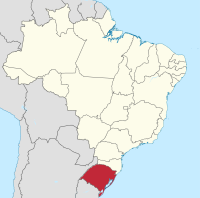
Photo from wikipedia
Abstract The identification of hydrogeochemical anomalies in karst water resources represents a crucial step in Brazil's water management plans. Accelerated urban and industrial development occurs in the region that includes… Click to show full abstract
Abstract The identification of hydrogeochemical anomalies in karst water resources represents a crucial step in Brazil's water management plans. Accelerated urban and industrial development occurs in the region that includes the Carste Lagoa Santa Protection Unit, State of Minas Gerais, which may negatively impact its water quality. This paper establishes Natural Background Levels (NBL) of waters collected from deep tubular wells and springs for Si4+, Ca2+, Mg2+, Na+, K+, HCO3−, SO42, Cl− to understand sources of possible geogenic and anthropogenic anomalies. Areas with surpassed thresholds were compared with geological, hydrogeochemical, and land use data. Every parameter, except for chloride, showed elevated concentrations due to lithologic origin. The NBLs for waters of wells and springs are, respectively, 17.9 and 12.7 mg/L (silica), 97.0 and 91.5 mg/L (calcium), 4.9 and 2.9 mg/L (magnesium), 6.2 and 3.8 mg/L (sodium), 1.0 and 0.3 mg/L (potassium), 285.5 and 254.6 mg/L (bicarbonate), 9.4 and 13.6 mg/L (sulfate). Chloride, analyzed only in groundwater, presented 6.7 mg/L indicating a possible influence of upstream urban areas of Lagoa Santa and Pedro Leopoldo municipalities. Volatile and Semivolatile Organic Compounds were also analyzed, but all of them were below the detection limit. This work is important to comprehend the NBL of major elements, reveal geogenic anomalies, and distinguish carbonate aquifer units from the impure ones.
Journal Title: Journal of South American Earth Sciences
Year Published: 2020
Link to full text (if available)
Share on Social Media: Sign Up to like & get
recommendations!